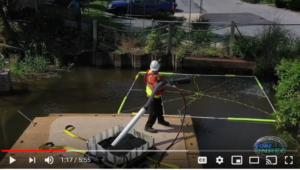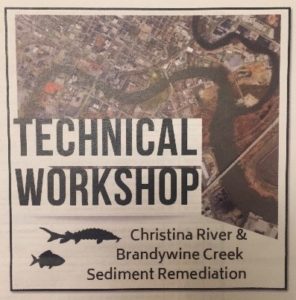The Christina River has an industrial history that left its mark in the form of pollution from chemical contaminants like PCB’s, pesticides, heavy metals and volatile organic compounds in some areas. Today, most of this pollution comes either from water that runs off polluted land near the Christina River or from sediments (mud) in the river itself. To address this, the Christina Conservancy is working with the Delaware Department of Natural Resources and Environmental Control (DNREC) and others to advance the cleanup of these sediments, most recently through the Christina Brandywine River Remediation, Restoration and Resilience (CBR4) project.
In the Christina River Watershed, there are numerous sites on land where contamination is being addressed or investigated, through DNREC’s Remediation Section, Brownfields Program, Voluntary Cleanup Program, and HSCA Program. Through these programs, sites are sampled for a consistent suite of environmental contaminants broadly classified as Volatile Organic Compounds (VOCs), Semi-Volatile Organic Compounds (SVOCs), Pesticides, Polychlorinated Biphenyls (PCBs) and Metals according to USEPA- and DNREC-defined standards. When sites are adjacent to water bodies, sediment samples are collected to assess potential impact of each site on the health of the waters.
In water bodies of the Christina River Watershed, samples have indicated that PCBs, dieldrin and chlordane are present in the environment at levels requiring further attention under the Clean Water Act. The Christina River Watershed is on the 303d list of impaired waters as well as having State of Delaware Fish Consumption Advisories for PCBs, dieldrin and chlordane.
But there is reason for optimism. Of the top ten most contaminated sites along the lower Christina River, four have been remediated and the remaining six are in the process of being remediated. Improvements in fish consumption advisories in recent years indicate that cleanup efforts are working to improve water quality.
 DNREC and others are using new technologies to clean up sites not just along but within waterways, like the A Street Ditch Remediation Project show in this video by DNREC (click on image to view video on YouTube). Learn more about DNREC’s Watershed Approach to Toxic Assessment and Remediation (WATAR) at http://www.dnrec.delaware.gov/dwhs/SIRB/Pages/WATAR.aspx.
DNREC and others are using new technologies to clean up sites not just along but within waterways, like the A Street Ditch Remediation Project show in this video by DNREC (click on image to view video on YouTube). Learn more about DNREC’s Watershed Approach to Toxic Assessment and Remediation (WATAR) at http://www.dnrec.delaware.gov/dwhs/SIRB/Pages/WATAR.aspx.
To view reports for sites in the DNREC-RS program please follow the link the DNREC Environmental Navigator to search by map for the Christina River Watershed. For a report on chemical contamination in the Christina Watershed use this link: DNREC environmental report.The DelawareWatersheds.org website also has posted information on contaminants in the Christina River.


